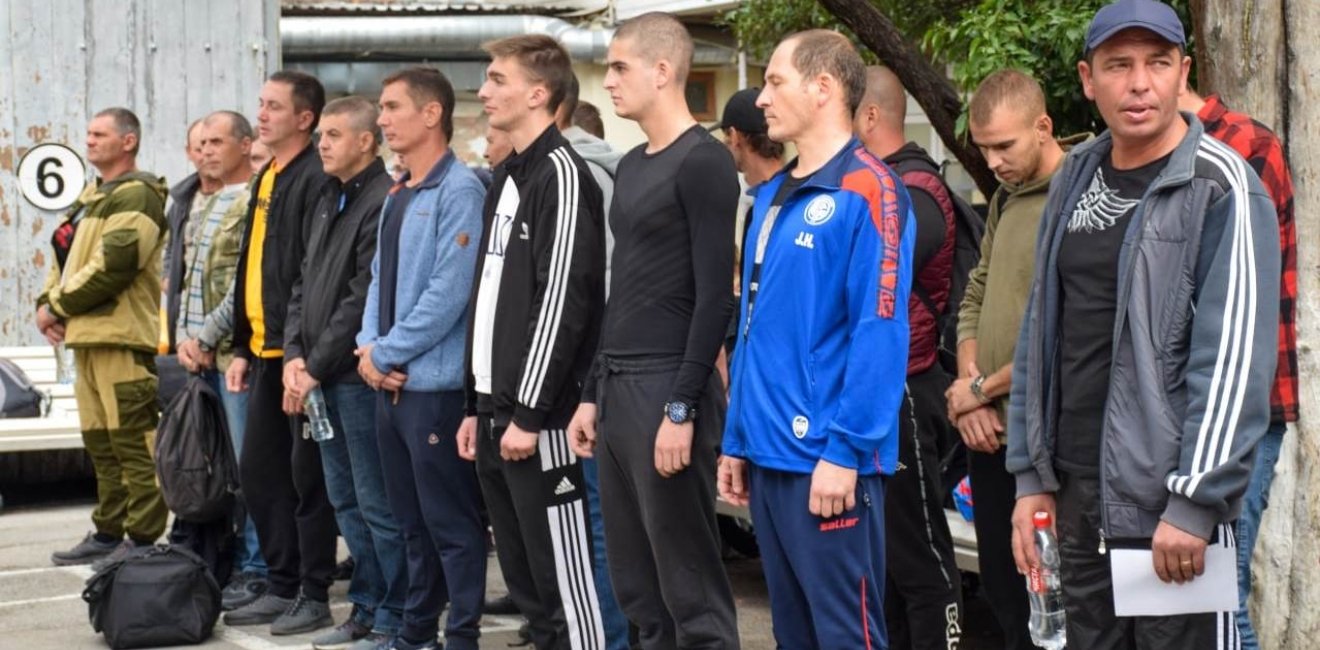
A blog of the Kennan Institute
BY MIKHAIL FISHMAN
A middle-aged man in military uniform, unshaven and with graying hair, stands in a line with other prisoners of war, looking terrified. He’s lucky to be alive. He was captured in Kupyansk, near Kharkiv in Ukraine, where the Ukrainian military is still carrying out operations to secure its territorial gains after its successful offensive of a few weeks ago.
On September 21, the man had been drafted in Moscow as part of Vladimir Putin’s so-called limited mobilization. For certain new recruits, it took less than a week to make it from the mobilization center to the war. They are neither military professionals nor volunteers, just common people who have been pulled from their everyday lives and sent straight to the battlefield without any preparation. Based on estimates of Russia’s military casualties, every one of them has a less than 50 percent chance of surviving the war.
Putin urgently needs these hundreds of thousands of recruits to fill the gaps at the front line, once Russia's military retreat from near Kharkiv finally made him face reality: he is losing his war in Ukraine, and before winter, he might even have to cede more of the previously occupied territories. For Putin, that would be more than a strategic failure; it would be the key defeat of his life. For that not to happen he is ready to pay with the lives of tens of thousands of Russians. His plan is to hold the line with additional manpower until next spring, in the hope that by then the West’s support of Ukraine will have begun to dissipate.
On September 16, Putin met with the leaders of Asian countries in the Shanghai Cooperation Organization in Samarkand and assured India’s prime minister Narendra Modi and Turkey’s president Recep Tayyip Erdoğan that he wanted to see an end to his war with Ukraine sooner rather than later. A few days later, however, on September 21, back home once more, he dramatically escalated the war with certain pivotal decisions, declaring mass—though officially limited—mobilization and urgent annexation of the occupied territories of Ukraine through sham referenda.
The annexation decision—accompanied by nuclear threats to the West—sent the message that Putin will not back down. His latest moves are meant to embarrass and deter the West at this crucial moment, with the option of a nuclear strike on the table in case things start to look really ugly on the battlefield. They also mean that he has made his final choice between the real world and the fictional universe he has been building in Russia over the course of the last twenty-two years.
For Putin, after September 21, there is no way back to reality. For almost two decades the Kremlin has been busy transforming the Soviet victory over Nazi Germany into a matter of religious observance. In 2014, Russian propaganda presented the invasion of parts of the Donbas as a sequel to World War II. Seven months ago, Putin declared the objective of “denazification" of Ukraine when he started his full invasion. Now, in Putin’s universe, the first mass mobilization in Russia since World War II resets time to 1941, when Hitler invaded Soviet Russia.
Now, Putin portrays himself as Stalin, leading his nation through an existential fight with the liberal “Nazi" West—in Ukraine. Symbolically, the annexation of the occupied territories mirrors the famous order “Not one step back” that Stalin issued in July 1942 after the Red Army suffered a major defeat in the battle of Kharkiv. (More than that, Putin literally copied Stalin’s order, having personally rejected his commanders’ requests to retreat both from Kherson in the south and from the northeast of Ukraine, as the New York Times reported last week.)
Putin’s invasion of Ukraine—and, broadly, Putin’s rule as such—were initially based on totalitarian ideas. Now, as every Russian has a relative, a friend, a neighbor, or a teammate who has been affected by mobilization, the analogy with Stalinism is complete. The totalitarian order has been restored not symbolically, but practically. Once again, the entire nation is terrorized. Once again, the state is in charge of human lives.
Once again, a knock on the door at 6 am, a police officer and agents at the entrance uttering the words “You have 30 minutes to pack your stuff,” have become Russia’s reality. In Russian villages, there are reported cases of all or almost all men being taken away. Under Stalin, they were sent to the gulag or executed. Today they are sent straight to the battlefield. During collectivization, Stalin locked farmers and their families in kolkhozes, Soviet collective farms. Now, military enlistment offices ban reservists from leaving their areas of residence. Just as during the Great Purge, Moscow is notifying the local level of command how many people are needed: back then it was for repression, now it is for mobilization.
And just as under Stalin, Russia’s rural, remote parts suffer more, as they are disproportionally more heavily affected by Putin’s mobilization. (Reported benchmark figures show, for instance, that poor and remote from the federal center Dagestan or Buryatia are required to enlist around twice as many men as urbanized regions of Ekaterinburg or Nizhny Novgorod.) In the twenty-first century, Stalinism is returning to a nation of smartphones and the internet, to cities of electric scooters and ride-sharing, to a modern Russia of coffee shops and burger joints. In Moscow, a city with an abundant cultural and social life and advanced public services, mobilization centers are being opened in museums and theaters.
Over the course of the past two decades, Putin’s fiction has taken root in Russia: a big part of the nation agrees to live in his dystopian universe. Not so many Russians explicitly deny Ukraine its right to exist. But there is a big group that agrees with mobilization, out of lack of agency and weakness of will. And these people are ready to go to war. “If it has to be done, it has to be done,” they say. “Those at the top know better than we do.” With almost biblical obedience, their relatives help them pack their bags and bid them farewell for a journey that is very likely to be their last, in striking contrast to the mid-1990s, when the war in Chechnya was almost unanimously rejected by Russian society.
According to Russian sociologist Trilena Koneva, in the first two days of the mobilization, support for it was rather high, approaching 50 percent of Russians—a big number. However, she expects support will quickly decrease with every passing day as accounts of lawlessness, abuse, and lack of preparedness for mobilization continue to accumulate and go viral. In a short time span, she expects, the approval of mobilization will drop to 30 percent maximum. It is not a coincidence that before the mobilization had even reached the end of its first week, the Kremlin had launched a PR campaign against the local military command. State propaganda blames generals for “mistakes,” for breaching Putin’s order of “limited mobilization” with their arbitrary and massive draft effort—very much in line with Stalin’s charge of “occasional overzealousness” of 1930, when collectivization caused massive resistance across rural Russia.
Yet there exists another Russia, one that rejects Putin’s fiction when it finally directly affects their lives and poses the stark issue of life or death. Millions of Russians fiercely refuse to take part in his brutal and bloody remake of World War II. Hundreds of thousands have left Russia in a matter of days, and tens of thousands more are stuck at checkpoints, desperately attempting to flee before the Kremlin closes the borders, a move that without a doubt will be vigorously opposed across the nation. These images of mass exodus—also almost biblical—prove that another big part of Russia is looking for a way out of Putin’s dystopia, isolated from the world by propaganda and repression.
Bound by the blood he has shed, by the war crimes his military has committed, and by the consequential choices he has made, Putin will never be able to abandon the myth of the existential climactic battle with the West; the narrative he has spun and his very real actions leave him no room to escape. But Russia has other options.
The opinions expressed in this article are those solely of the author and do not reflect the views of the Kennan Institute.
Author

Russian Journalist and Filmmaker

Kennan Institute
After more than 50 years as a vital part of the Wilson Center legacy, the Kennan Institute has become an independent think tank. You can find the current website for the Kennan Institute at kennaninstitute.org. Please look for future announcements about partnership activities between the Wilson Center and the Kennan Institute at Wilson Center Press Room. The Kennan Institute is the premier US center for advanced research on Eurasia and the oldest and largest regional program at the Woodrow Wilson International Center for Scholars. The Kennan Institute is committed to improving American understanding of Russia, Ukraine, Central Asia, the South Caucasus, and the surrounding region through research and exchange. Read more

Explore More in The Russia File
Browse The Russia File
Chechnya as a Model of Modern Russia

Russia’s Indigenous Communities and the War in Ukraine

Gas and Power in a Changing US–Russia Relationship

